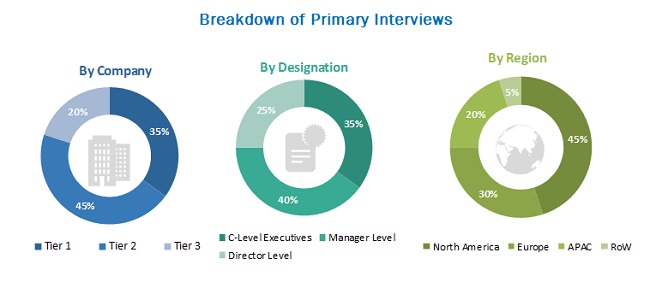Low Carbon Propulsion System Market by Engine type (Gas Turbine Engine, Turboelectric Engine, Hybrid Engine, Fully Electric Engine), Platform (Fixed Wing, Rotary Wing), Application Type (Commercial Aviation, General Aviation, Business Aviation, Military Aviation), Power Source (Sustainable Aviation Fuel, Aviation Gasoline, Battery, Fuel Cells) and Region - Global Forecast to 2025
The study involved four major activities in estimating the current market size for the low carbon propulsion system. Exhaustive secondary research was undertaken to collect information on the market, the peer markets, and the parent market. The next step was to validate these findings, assumptions, and sizing with industry experts across the value chain through primary research. Both top-down and bottom-up approaches were employed to estimate the complete market size. Thereafter, market breakdown and data triangulation procedures were used to estimate the market size of segments and subsegments
Secondary Research
In the secondary research process, various secondary sources, such as D&B Hoovers, Bloomberg, BusinessWeek, and different magazines, were referred to identify and collect information for this study. Secondary sources also included annual reports, press releases & investor presentations of companies, certified publications, articles by recognized authors, and aircraft power electronics databases.
Primary Research
The low carbon propulsion system market comprises several stakeholders, such as aircraft electric system providers, engine manufacturers, regulatory organizations, research bodies, and aircraft OEMs in the supply chain. The demand side of this market is majorly characterized by aircraft OEMs. The supply side is characterized by technology advancements in low carbon emitting propulsion system and its efficiency. Various primary sources from both the supply and demand sides of the market were interviewed to obtain qualitative and quantitative information. Following is the breakdown of primary respondents:

Market Size Estimation
Both, top-down and bottom-up approaches were used to estimate and validate the size of the low carbon propulsion system market.
The research methodology that was used to estimate the size of low carbon propulsion system market included the following details:
- Key players in the low carbon propulsion system market were identified through secondary research, and their market shares were determined through primary and secondary research.
- All percentage shares, splits, and breakdowns were determined using secondary sources and were verified through primary sources.
- All possible parameters that affect the markets covered in this research study were accounted for, viewed in extensive detail, verified through primary research, and analyzed to obtain the final quantitative and qualitative data on the low carbon propulsion system market.
Data Triangulation
After arriving at the overall size of the low carbon propulsion system market through the market size estimation process explained above, the total market was split into several segments and subsegments. The data triangulation and market breakdown procedures were implemented, wherever applicable to complete the overall market engineering process and to arrive at the exact statistics for various market segments and subsegments. The data was triangulated by studying various factors and trends from both, demand and supply sides. Along with this, the market size was validated using both, top-down and bottom-up approaches.
Objectives of the Report
- To define, describe, and forecast the size of the low carbon propulsion system market based on engine type, application, power source, platform and region
- To forecast the size of the market and its segments with respect to 4 major regions, namely, North America, Europe, Asia Pacific, and Rest of the World, along with their respective key countries
- To identify and analyze key drivers, opportunities, and challenges influencing the growth of low carbon propulsion system market
- To identify industry trends, market trends, and technology trends currently prevailing in the low carbon propulsion system market
- To strategically analyze micromarkets with respect to individual technological trends and their contribution to the total low carbon propulsion system market
- To strategically profile key market players and comprehensively analyze their market share and core competencies
- To track and analyze competitive developments such as contracts and new product launches in the low carbon propulsion system market
- To analyze the degree of competition in the market by mapping the contracts received and products and services offered by key market players
- To identify detailed financial positions, key products, and unique selling points of leading companies in the market

Want to explore hidden markets that can drive new revenue in Low Carbon Propulsion System Market?
Scope of the Report

Want to explore hidden markets that can drive new revenue in Low Carbon Propulsion System Market?
|
Report Metric |
Details |
|
Market size available for years |
2018–2025 |
|
Base year considered |
2019 |
|
Forecast period |
2020–2025 |
|
Forecast units |
Value (USD) |
|
Segments covered |
By Engine type, Application, Platform, Power source |
|
Geographies covered |
North America, Europe, Asia Pacific, and Rest of the world |
|
Companies covered |
General Electric Company (U.S.), United Technologies Corporation (U.S.), Rolls-Royce Holdings plc. (U.K.), Honeywell International Inc. (U.S.), Safran SA (France), Textron, Inc. (U.S.), and Northrop Grumman (U.S.) |
This research report categorizes the low carbon propulsion system market into the following segments and subsegments:
By Engine Type,- Gas Turbine Engine
- Turbo-electric engine
- Hybrid
- Full-electric
By Platform
- Fixed Wing
- Commercial Aircraft
- Business Jet
- Light aircraft
- Military aircraft
- UAV
- Rotary Wing
- Civil & commercial
- Military
- UAV
By Application
- Commercial Aviation
- General Aviation
- Business Aviation
- Military Aviation
By Power Source
- Sustainable Aviation Fuel (Bio-fuels)
- Aviation gasoline
- Battery
- Fuel cells
Available Customizations:
Along with the market data, MarketsandMarkets offers customizations according to the specific requirements of companies. The following customization options are available for the report:
- Country-level analysis
- Market sizing and forecast for additional countries
- Additional company profiles (up to 5)
















Growth opportunities and latent adjacency in Low Carbon Propulsion System Market